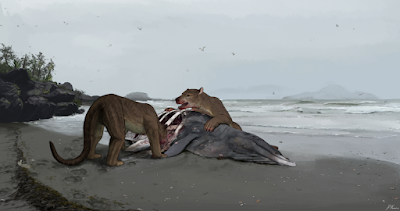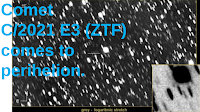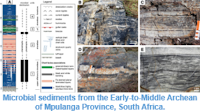Amphicyonids, or Beardogs, are an extinct group of Carnivoran Mammals known from the Eocene to Pleistocene of Europe, Asia, Africa and North America. Opinions on their relationship to other Carnivorans vary, with some palaeontologists feeling they are more closely related to Dogs and others that they are more closely related to Bears. Amphicyonids were for the most part large animals, including the earliest specimens, and most species are interpreted as having had either a hypercarnivorous diet (diet with a very high proportion of meat, similar to that of modern Cats), or to have been bone-crushing durophages (similar to modern Hyenas). The first Amphicyinids appear in the fossil record in Europe during the Eocene, with the group reaching North America during the Early Miocene.
In a paper published in the journal PeerJ on 15 June 2022, Floréal Solé of the Royal Belgian Institute of Natural Sciences, Jean-Francois Lesport, an independent researcher from Sainte-Hélène in France, and Antoine Heitz and Bastien Mennecart of the Naturhistorisches Museum Basel, describe a new species of Amphicyonid Beardog from the Middle Miocene Faluns bleus deposits of Aquitaine, France.
The Faluns bleus deposits record a marine transgression in Aquitaine during the Serravallian (Middle Miocene, 13.82-11.63 million years ago). These deposits have produced a plethora of marine fossils laid down in a shelly sandstone, which have been studied by palaeontologists since the 1830s. The deposits are thought to represent a nearshore environment with a subtropical climate, and are most noted for their numerous Mollusc fossils.
The new species is described from a single mandible found by Jean-Francois Lesport and Philippe Renard in 1993, within a micro-conglomerate within the Faluns blues. This specimen has been donated to the Natural History Museum of Bordeaux by Jean-Francois Lesport, and is available to other researchers under the specimen number
MHNBx 2020.20.1; in addition the specimen has been 3D surface scanned, and to make a model which can be downloaded from here.
The new species is named Tartarocyon cazanavei, where 'Tartarocyon' is a combination of 'Tartaro', a legendary man-eating giant supposed to have lived in the Southwestern
French Pyrenees (i.e. the area where the fossil was found), and 'cyon', the Greek for 'Dog', while 'cazanavei' honours Alain Cazanave, who owned the location where the fossil has found, and helped with it's extraction.
The specimen is a single right mandible with the second, third, and fourth premolars present, as well as the alveoli of the incisors, canine, first canine, and first, second, and third molars. There are diastemata (gaps) between the canine and first premolar, first and second premolars, second and third premolars, and third and fourth premolars, with that between the second and third premolars being the largest.
Holotype (MHNBx 2020.20.1) of Tartarocyon cazanavei from Sallespisse
(MN7/8, Southwest France), in occlusal, lingual, and labial views. Scale bar is 5 cm. Solé et al. (2022).
Most of the features used to determine relationships within the Amphicyonidae are associated with the molars, which are not preserved in MHNBx 2020.20.1, making it hard to determine how Tartarocyon cazanavei is related to other members of the group, although it's tooth numbering makes it likely that it is a member of the Subfamily Thaumastocyoninae.
Solé et al. estimate that Tartarocyon cazanavei had a body mass of 194.91 kg. This is large for a Amphicyonid, comparable to Amphicyon major, Amphicyon pannonicus, Magericyon spp., and Megamphicyon carnutense, although smaller than the very largest species, such as Megamphicyon giganteus, Amphicyon gutmanni, Amphicyon eppelsheimensis, and Amphicyonopsis serus.
Amphicyonids have been divided into four dietary groups; omnivores, mesocarnivores, bone-crushing durophages, and hypercarnivores. Hypercarnivores show a reduction in the number of premolars and molars, which is not the case with Tartarocyon cazanavei, ruling this out as an ecological role for the species. Mesocarnivory in Amphicyonids is known only in smaller species, and is associated with closely appressed
premolars and teeth with high crowns and blunt cuspids; this can also be ruled out for Tartarocyon cazanavei. Omnivory in Amphicyonids is also associated with small species, making it unlikely Tartarocyon cazanavei was an omnivore. Durophageous Amphicyonids typically have complete sets of molars and widely spaced premolars, making it highly likely that Tartarocyon cazanavei was a durophage. Furthermore, most such species were of comparable size to Tartarocyon cazanavei, further supporting this hypothesis.

Reconstruction of Tartarocyon cazanavei feeding on a stranded Dolphin
by the Serravallian Sea. Little is known of the inland environmental conditions where Tartarocyon
lived. This illustration thus combines all the data from the site la Crousquillière in Sallespisse including the
intertidal dark deposits, the abundance of the Molluscs, and the mandible of Tartarocyon in the high-tide
line. Denny Navarra in Solé et al. (2022).
The survival of different ecological groups of Amphicyonids in Europe has been linked to climatic and environmental change. Smaller, mesocarnivorous forms largely disappeared at the end of MN5 (about 13.7 million years ago), which may have been related to the related to the Middle Miocene Climatic Transition, during which the climate cooled significantly, and became more arid. From this point on the majority of Amphicyonids were either hypercarnivores or durophages, with only a small number of omnivorous species.
Amphicyonids were also impacted by the Vallesian Crisis, about 9.7 million years ago. This was marked by a spreading of more open, grassland environments, and a subsequent loss of many dense, woodland environments. This again seems to have reduced diversity within the group, with only large hypercarnivorous and durophageous forms surviving.
Body mass and diet distribution of Amphicyonids during the Miocene. Solé et al. (2022).
See also...
Online courses in Palaeontology.
Follow Sciency Thoughts on Facebook.
Follow Sciency Thoughts on Twitter.






















































